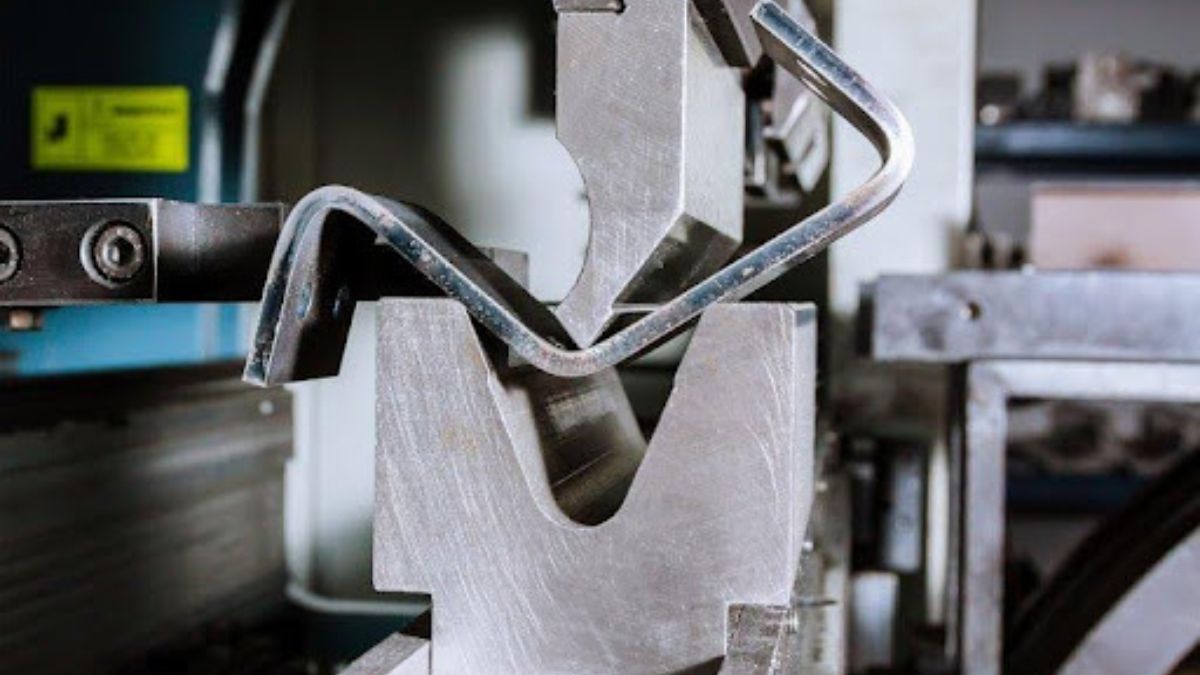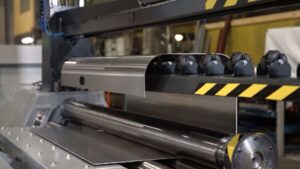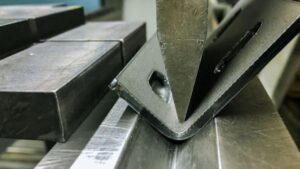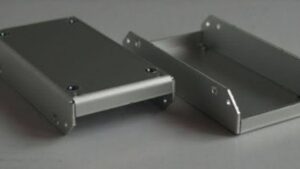TECHNOLOGY
An Informative Guide to Bending Sheet Metal

Sheet metal bending is one of the effective fabrication techniques product designers utilize to produce reliable and high-quality metal components. This metal forming technique is suitable for low production runs, which might require thin metal to make components when casting fails to provide the desired outcomes.
This article provides an in-depth discussion of everything you need to know about bending sheet metal and a step-wise guide to the process. You will find out the standard sheet metal bending techniques, applications, and helpful considerations for effective sheet metal bending!
Overview of Sheet Metal Bending
Sheet metal bending (also known as edging, forming, flanging, die bending, or press braking) is a standard metal forming process that involves applying a force to a metal sheet with a press brake to create a radius. Manufacturers and product designers often use sheet metal bending techniques to create components like fridges, electronic casings, vehicle body panels, and brackets.
Product engineers bend metal sheets once or multiple times to achieve the final geometry. However, manufacturers often use sheet metal of varying thickness. The minimum thickness of sheet metal suitable for bending is about 127 mm, while the material type and thickness frequently determine the maximum thickness. However, sheet steel is not usually more than 6 mm thick. Hence, the bend radius should be the same or greater than the material’s thickness.
A Stepwise Guide to Bending Sheet Metal

While a press brake is the most commonly used tool for bending sheet metal, it is mechanical and completely manual. Machinists use various CNC (computer numerically controlled) machines with a hydraulic system. Although they have the same working principle, the operator’s interaction differs. We’ll explore steps on how to use a CNC press brake machine to bend sheet metal below:
Step 1: Evaluate the Design Parameters
Ensure you calculate the design parameters such as required force, bend line (the point where the force is applied), and the order of bends (when you need to bend multiple times). Additionally, you have to determine the required die to create the bends.
Step 2: Prepare the Press Brake
Here, you must program the CNC press brake machine with the calculated information, preparing it for the bending operation. As such, the machine understands the required force to exert on the metal sheet to form the right bend and the required order for the bends. In addition, the right tool and die must be attached to the press and brake to make the bend.
Step 3: Align the Workpiece
Ensure the sheet metal is correctly aligned between the tool and die after the machine has been set up. Position the workpiece in the designated area and clamp it tightly to avoid deflection or inaccurate bending. The CNC machine will bend the sheet metal at the bend line once it begins operation.
Step 4: Engage the Press Brake
You have to engage the press brake for it to apply the force parameters programmed into the CNC press brake earlier in the process. Proceed to remove the part once the press brake has bent the sheet metal. Then, prepare for the next stage of production.
Step 5: Inspect and Make Adjustments
Inspect the workpiece carefully for any flaws or necessary adjustments after you have unclamped it. If the bend is inaccurate, you can make minor adjustments with a mallet or hammer. However, you may need to reposition the sheet in the brake and re-bend if the bend angle is slightly off,
Standard Sheet Metal Bending Techniques

Sheet metal bending involves deforming metal sheets along a straight axis using various techniques to achieve varying shapes and bend angles. Here are typical techniques for bending sheet metals to the desired angles:
V-bending
This widely used sheet metal bending technique employs a v-shaped die and a punch in bending sheet metals at preferred angles. The v-shaped punch presses the sheet metal workpiece into the v-shaped groove in the die, forming the metal sheet with different bend angles. For instance, you can make 90°, acute or obtuse angles based on the v-shaped punch and die angle.
U-bending
U-bending is a typical metal sheet bending technique that forms the sheet metal into a U-shape. It involves placing the sheet metal on the U-shaped die that creates two parallel bends with a flat section in between, then using a punch to press it down to force the metal into the U-shaped groove, forming a U-bend. This technique is ideal for making channels and enclosures for different applications.
Air Bending
Like the V-bending, air bending relies on a v-shaped punch and die to bend metals into preferred shapes. However, the punch in the air bending technique leaves space/air below the sheet instead of forcing sheet metal to the cavity’s bottom, allowing more bend angle control.
For instance, you can achieve bend angles ranging between 90° and 180° using the air bending methods if you have a 90° die and punch. Since less springback occurs in this metal bending technique, it provides a more accurate outcome. Springback is often avoided since it can lead to inaccurate bends.
Wipe Bending
This method lets you bend sheet metal into the desired geometry by holding the workpiece against a wipe die with a pressure pad. Then, the punch forces the metal sheet’s edge to extend beyond the die and pressure pad, making it bend over the die’s end.
The wipe bending method provides exceptional mechanical advantages, such as applying less force to achieve the preferred bends and bend angles. Nevertheless, this technique might be unsuitable for making obtuse bend angles because you might need sophisticated machinery capable of producing horizontal force.
Rotary Draw Bending
The rotary draw bending technique involves clamping the sheet metal to a rotary die and drawing around the die to produce a geometry whose radius meets the preferred bend radius. Product engineers typically utilize an internal supporting mandrel in this method to avoid wrinkling on the bent sheet metal’s wall.
The rotary draw bending technique provides extensive benefits compared to other sheet metal bending methods. One of the many benefits of the rotary draw method is that it doesn’t scratch the surface of the sheet metal and can bend metals into sharp corners with obtuse bend angles.
Bottoming
Bottoming bending is a variant of v-bending that mitigates the springback issue by pressing the workpiece down to the bottom of the die, making the workpiece touch the edge of the v- or u-shaped die. It applies additional force through the tip of the punch to deform the sheet metal in the bend region. Also, bottoming is similar to the air bending method because it offers a precise bend angle control.
Roll Bending
In roll bending, you can bend metal sheets into cones, tubes, rolls, and curved shapes. This forming method relies on rollers that feed the metal stock to the desired curvature. The roll bending technique allows you to bend metals into different cross-section profiles comprising various bending curves. It is mainly suited for producing very long sheet metal parts with 0.004 to 0.125 inches range and approximately 20 inches width.
For example, the roll bending machine can create common metal parts used in buildings for roofing, lighting, and HVAC applications such as shelving, panels, and tracks.
Helpful Tips to Consider When Bending Sheet Metal

Even though sheet metal bending types offer desirable outcomes, the process can become complicated if the technique is wrong. Hence, we will discuss helpful tips to ensure you create perfect bends on sheet metals below:
Pick the Right Material
Although different metals are compatible with sheet metal techniques, some are relatively more malleable than others. Hence, it would be best to be mindful of the use of heat and reduce any material cracking and weakening if necessary. Copper, mild steel, galvanized steel, stainless steel, and aluminum are typical materials that work best for sheet metal bends. Copper offers antimicrobial benefits, stainless steel, galvanized steel, and stainless steel exhibit good corrosion resistance and malleability.
Determine Bend Allowance
Bend allowance recompenses what happens to the workpiece when stretched and formed into the desired bend from a flat pattern. Since the metal bending process involves material pushing, pulling, or stretching, you would have to calculate the bend allowance for the sheet metal to derive reliable measurements to work with when you lay out a flat metal sheet. However, when calculating bend allowance, you must consider variables such as internal radius size and material thickness.
Protect the Sheet Metal’s Surface
Preventing the metal’s surface from scratches when bending is essential to attain a fine surface finish. You can use masking tape in any area that comes in contact with something hard. Also, wood blocks effectively protect the appearance of your metal when bending.
Prevent Sharp Internal Corners
When bending metal sheets to desired forms, avoid bending to a sharp internal corner because it can crack or weaken the metal. However, have a radius on your bending tool to mitigate this complication. Additionally, ensure the inside bend radius is the same as the thickness of the material you are bending.
Conclusion
Bending sheet metal is an integral fabrication process with a distinct edge over other manufacturing methods. It offers lower cost, high design flexibility, and increased output, providing functional components and structures for several applications. However, the application’s specific requirements, such as the type of metal, required shape, and production volume, will determine the ideal sheet metal technique for your project. Always work with a professional sheet metal fabricator to get the best results.
TECHNOLOGY
Woofapps: Innovative Pet Technology Solutions Explained

In today’s rapidly evolving digital age, technology is transforming every aspect of life—including how we care for our pets. Enter Woofapps, a cutting-edge pet technology platform designed to enhance pet wellness, safety, training, and communication. From GPS tracking to smart feeding and vet integration, Woofapps is making pet ownership more informed, efficient, and enjoyable than ever before.
Whether you’re a seasoned pet parent, a new dog owner, or a pet care professional, understanding how Woofapps is revolutionizing pet tech can help you improve your furry friend’s quality of life.
In this article, we break down what Woofapps is, how it works, and why it’s the future of pet technology solutions.
What is Woofapps?
Woofapps is an ecosystem of smart tools, mobile apps, and AI-driven services specifically designed for pets and their owners. The platform combines wearable pet devices, mobile connectivity, cloud-based data analytics, and real-time monitoring features to deliver holistic pet care solutions.
The focus of Woofapps is to solve common pet care challenges using smart technology, offering solutions in:
-
Pet health tracking
-
Activity monitoring
-
Training and behavior
-
Veterinary integration
-
Smart feeding
-
GPS and geofencing
-
Pet social networking
Whether it’s a dog, cat, or another companion animal, Woofapps provides personalized, data-backed insights to ensure pets live healthier, happier lives.
Key Features of Woofapps
1. Smart Collars and Wearables
At the core of Woofapps’ technology are its AI-enabled smart collars. These wearable devices monitor:
-
Daily activity and sleep cycles
-
Heart rate and breathing patterns
-
Location tracking via GPS
-
Barking behavior and sound triggers
-
Temperature and environment
Owners receive real-time data on their smartphones through the Woofapps mobile dashboard, allowing them to monitor and react to their pet’s needs instantly.
2. GPS Location and Geofencing
Lost pets are a major concern. Woofapps tackles this with advanced real-time GPS tracking and customizable geofencing. If your pet leaves a safe zone, the app immediately notifies you. You can even use location history to identify escape patterns or explore new walking paths.
3. Pet Health and Wellness Reports
Using data from smart collars and optional health integrations, Woofapps generates automated health summaries:
-
Caloric burn estimates
-
Symptom alerts (e.g., increased scratching or lethargy)
-
Vet visit reminders
-
Weight trends and dietary recommendations
This continuous health monitoring helps detect early signs of illness and streamlines communication with veterinarians.
4. Training and Behavior Tracking
The platform includes AI-driven tools for training and behavior analysis, such as:
-
Clicker and voice command tools
-
Reinforcement pattern tracking
-
Behavior trend logs
-
Feedback on anxiety levels and restlessness
Trainers and pet parents alike can customize plans, monitor behavior changes, and build routines directly through the app.
5. Smart Feeding Integration
Woofapps integrates with smart pet feeders that automate and personalize feeding schedules based on your pet’s age, breed, activity level, and health needs. Features include:
-
Portion control
-
Meal reminders
-
Feeding history and analytics
-
Allergy alerts and diet logs
It’s an excellent tool for pets on special diets or weight management programs.
6. Vet and Emergency Services Integration
Through cloud synchronization, users can share real-time data with veterinarians, schedule appointments, access telehealth services, and store medical records all in one place. In emergencies, the app can suggest the nearest 24/7 vet services using GPS data.
How Woofapps Benefits Pet Owners
✅ Peace of Mind
With 24/7 monitoring, owners know how their pet is doing—whether they’re at home, at work, or traveling.
✅ Improved Pet Safety
Features like emergency alerts, lost pet GPS tracking, and environmental monitoring dramatically reduce the risk of accidents and health crises.
✅ Time and Cost Efficiency
By catching early signs of illness, optimizing feeding, and simplifying vet communication, Woofapps helps avoid expensive emergency visits and wasted resources.
✅ Personalized Pet Care
Woofapps uses machine learning to personalize insights based on your pet’s behavior, age, breed, and lifestyle. The more data you provide, the smarter the recommendations become.
Woofapps and the Rise of Pet Tech in 2025
The global pet tech market is booming, projected to exceed $30 billion by 2025. As pet owners demand smarter ways to care for their animals, companies like Woofapps are setting the standard.
Here’s why Woofapps is uniquely positioned to lead:
-
Cross-device compatibility (Android, iOS, wearables)
-
Cloud and AI-powered data processing
-
Partnerships with vet clinics and pet food brands
-
Focus on ethical data usage and pet privacy
-
User-friendly interface and accessibility
In 2025, pet tech isn’t a luxury—it’s quickly becoming a necessity for proactive pet parenting.
Woofapps vs. Other Pet Tech Platforms
| Feature | Woofapps | Fi Smart Collar | Whistle Health | Pawtrack |
|---|---|---|---|---|
| Real-time GPS tracking | ✅ Yes | ✅ Yes | ✅ Yes | ✅ Yes |
| Vet integration | ✅ Yes | ❌ No | ✅ Yes | ❌ No |
| Smart feeding support | ✅ Yes | ❌ No | ❌ No | ❌ No |
| Training and behavior tools | ✅ Yes | ❌ No | Limited | ❌ No |
| Cloud-based health insights | ✅ Yes | ❌ No | ✅ Yes | ❌ No |
| Social features for pet owners | ✅ Yes | ❌ No | ❌ No | ❌ No |
Conclusion: Woofapps offers a comprehensive suite of features in a single ecosystem—giving it a significant edge over niche competitors.
How to Get Started with Woofapps
Step 1: Download the App
Available on Google Play Store and Apple App Store, the Woofapps app is free to download with optional premium features.
Step 2: Connect a Smart Device
Link your pet’s Woofapps smart collar or compatible device. Bluetooth and Wi-Fi syncing allow real-time data uploads.
Step 3: Create a Pet Profile
Input your pet’s:
-
Name
-
Breed
-
Age
-
Weight
-
Health history
-
Behavioral traits
This helps the app tailor its analytics and recommendations.
Step 4: Explore the Dashboard
From activity summaries to feeding logs, the user-friendly dashboard provides instant insights. You can also connect with your vet and set reminders.
Step 5: Join the Community
Woofapps also includes a social hub where pet owners can share updates, swap tips, and participate in local pet-friendly events.
Future of Woofapps: What’s Next?
Woofapps is continuously evolving. In 2025 and beyond, expect features like:
-
AI-powered symptom diagnosis
-
Pet-to-owner communication via smart speakers
-
DNA-based diet customization
-
Multi-pet household support
-
Integration with smart home ecosystems
As the pet-tech landscape grows, Woofapps aims to remain at the forefront through innovation, usability, and trust.
Final Thoughts
Woofapps represents the future of smart pet care—where technology meets compassion. By combining data, automation, and real-time communication, the platform is redefining how we interact with our furry companions.
Whether it’s tracking health, preventing illness, reinforcing training, or just making daily care easier, Woofapps offers an all-in-one solution that empowers pet owners like never before.
TECHNOLOGY
Newtopy – A Rising Star in Digital Media and Trend Culture

In an era dominated by fast-moving trends, algorithmic virality, and content overload, standing out in the digital media landscape is no small feat. Yet, Newtopy, a relatively new entrant into the space, has carved a niche for itself as a leading force in digital media and trend culture. With a refreshing approach to storytelling, cultural commentary, and community engagement, Newtopy is rapidly emerging as one of the most influential platforms for Gen Z and millennials around the globe.
The Birth of a Digital Vision
Founded in the early 2020s, Newtopy began as a passion project by a small team of creatives, journalists, and digital strategists who noticed a growing disconnect between mainstream media and the rapidly evolving culture of internet-native communities. Traditional outlets were slow to adapt to the fluid nature of digital trends, often missing out on the nuances of meme culture, TikTok-driven phenomena, and emerging youth movements.
Newtopy sought to change that.
Rather than chasing the news cycle, Newtopy aimed to ride the wave of internet culture in real-time, capturing the essence of what’s hot, what’s coming next, and why it matters. Its name—Newtopy, a portmanteau of “new” and “topography”—hints at its mission to map the constantly shifting landscape of the digital world.
What Makes Newtopy Different?
In a crowded field of digital media startups, Newtopy has distinguished itself through three core principles: authenticity, agility, and audience-first content.
1. Authenticity in Voice and Values
Unlike traditional media platforms that often appear distant or corporate, Newtopy’s tone is unfiltered, witty, and deeply in tune with the culture it covers. Whether it’s a breakdown of the latest viral TikTok sound, an explainer on digital fashion trends in the metaverse, or a think piece on mental health in the influencer economy, Newtopy maintains a voice that feels real and relatable.
Moreover, the platform has taken a strong stance on social issues—from climate change and gender rights to digital privacy and creator economy ethics. Its willingness to speak out, even when controversial, has earned it loyalty from younger audiences who prioritize value alignment in their media consumption.
2. Agility in Content Creation
Newtopy’s newsroom operates more like a meme lab than a traditional editorial board. The team leverages real-time data analytics, social listening tools, and an ever-growing network of contributors to identify emerging trends before they go mainstream. This proactive approach enables Newtopy to publish thought leadership pieces, breakdowns, and video essays on viral topics within hours, sometimes minutes.
Their agility isn’t just in reporting—it extends to format experimentation. From vertical video series optimized for TikTok and Instagram Reels to long-form think pieces, interactive quizzes, and even augmented reality (AR) filters, Newtopy meets its audience where they are, in the formats they prefer.
3. Audience-First Culture
At the heart of Newtopy is a deep respect for its community. The platform doesn’t treat its audience as passive consumers but as co-creators and collaborators. Through regular polls, Discord chats, and creator spotlights, Newtopy fosters an ecosystem where users actively shape the content agenda.
Their open editorial submissions program encourages upcoming writers, artists, and digital creators to contribute stories, ensuring a diverse range of voices and perspectives are represented. This democratic, bottom-up approach to content creation makes Newtopy not just a media brand—but a culture hub.
Platforms and Reach
Newtopy’s content ecosystem spans a range of digital platforms, each tailored to maximize engagement:
-
Website & Blog: The editorial heart of Newtopy, housing in-depth articles, opinion pieces, and cultural analyses.
-
TikTok & Reels: Short-form video content breaking down trends, slang, fashion, and moments from internet history.
-
YouTube: Documentary-style video essays, interviews with cultural figures, and trend forecasts.
-
Newsletter: A weekly roundup of what’s trending and why, delivered with wit and visual flair.
-
Discord: An active community space for fans, creators, and editors to interact directly.
By distributing across multiple touchpoints, Newtopy ensures it remains deeply embedded in the daily digital habits of its audience.
Covering the Culture Engine
What Newtopy does best is decode the internet’s chaotic creativity. It dissects the things that move fast—memes, influencer drama, fashion drops, viral challenges—and then offers context, history, and thoughtful commentary. This dual approach of being both reactive and reflective makes it a favorite among internet-savvy readers who want more than just surface-level noise.
Some of Newtopy’s most notable coverage areas include:
-
Trend Spotting: Identifying and explaining micro-trends in fashion, beauty, tech, and lifestyle.
-
Internet History: Tracing the roots of memes, movements, or viral sounds and how they evolved.
-
Creator Economy: Stories about digital creators, monetization, burnout, and platform dynamics.
-
Digital Identity: Essays on how people present themselves online—avatars, filters, bios, and beyond.
-
Social Movements: How activism is shaped by platforms, from climate TikToks to online mutual aid.
Monetization Without Selling Out
One of the most impressive things about Newtopy is how it balances monetization with integrity. The platform has built sustainable revenue through native advertising, creator partnerships, and branded content that feels genuinely valuable to the audience.
They’ve also launched Newtopy Studio, a creative consultancy arm that helps brands understand and engage with youth culture authentically. By turning their cultural expertise into a service, Newtopy is diversifying its income while staying true to its editorial mission.
Challenges Ahead
No media company is without its hurdles. As Newtopy scales, it faces the classic tensions between editorial independence and commercial growth. There’s also the ongoing challenge of platform dependence—an algorithm tweak on TikTok or a policy change on Instagram could significantly impact reach and engagement.
Furthermore, staying relevant in a space that moves as fast as internet culture requires constant innovation and evolution. Newtopy must guard against becoming the very thing it set out to disrupt: a stale, reactive, legacy brand.
The Future of Newtopy
Looking ahead, Newtopy plans to expand into original content production, including web series, podcasts, and interactive storytelling formats. International expansion is also on the horizon, with regional content hubs in Latin America, Southeast Asia, and Africa.
Final Thoughts
In a digital world often cluttered with noise, Newtopy offers clarity, creativity, and cultural depth. It’s more than just a media brand—it’s a movement, a mirror, and a map of the ever-shifting digital topography. For those who want to understand where internet culture is going—and why—Newtopy is not just a rising star. It’s a guiding light.
TECHNOLOGY
Whoer.net: Enhances Online Privacy and Anonymity

We live in a digital world where every click, every scroll, and every login is potentially being watched. Whether you’re shopping online, streaming videos, or even just reading the news—your online behavior is being tracked. This constant surveillance has led millions to search for tools that help them reclaim their digital privacy. And one such tool standing strong in this fight for anonymity is Whoer.net.
Let’s dive deep into how Whoer.net enhances online privacy and anonymity for users across the globe.
What is Whoer.net?
Whoer.net is a multifaceted online privacy platform offering a suite of tools designed to safeguard your identity, mask your digital footprint, and keep your browsing habits under wraps. From VPN services to anonymity checks, speed tests, and browser fingerprinting diagnostics—Whoer is a one-stop destination for privacy-conscious users.
Launched as a response to rising global surveillance and cyber threats, it now serves millions of users who prioritize discretion and security.
Online Privacy in 2025: More Than Just a Buzzword
Digital privacy is no longer optional—it’s essential. From smart TVs listening to conversations to ISPs selling browsing data, the threats are everywhere. Even mainstream websites load dozens of trackers that log everything from your device model to your mouse movements.
Today’s online landscape is a labyrinth of corporate surveillance, algorithmic profiling, and targeted ads. In such a climate, tools like Whoer.net are more relevant than ever.
Why Online Anonymity Is Crucial
Anonymity goes hand-in-hand with freedom. Think about it—would you talk freely if every word was recorded? Probably not. Online anonymity ensures:
-
Protection from targeted advertising
-
Safety from identity theft
-
Freedom to express and research without judgment
-
Shielding from cyberstalkers and data brokers
It’s not about hiding something wrong. It’s about protecting what’s rightfully yours—your data.
How Does Whoer.net Work?
Whoer.net functions through an interconnected web of tools and services. At its core is the Whoer VPN, but that’s just the beginning. Here’s what it offers:
-
VPN servers in multiple countries
-
DNS leak protection
-
Kill switch feature
-
Speed and ping testing tools
-
WebRTC leak diagnostics
-
Browser fingerprint analysis
All designed to give you actionable insights about your current privacy level and how to improve it.
Understanding VPN: Your Invisible Cloak
A VPN (Virtual Private Network) encrypts your internet traffic and routes it through a remote server, masking your real IP address. This means:
-
You browse anonymously.
-
Hackers and ISPs can’t intercept your data.
-
Geo-restrictions can be bypassed.
With Whoer.net’s VPN, you gain this protective cloak with impressive speeds and stability.
Proxy vs VPN: Which One Do You Need?
While proxies also reroute your traffic, they lack the encryption VPNs offer. Use a proxy for:
-
Quick IP masking
-
Simple location changes
Use VPN for:
-
Complete encryption
-
Privacy on public Wi-Fi
-
Avoiding government censorship
Whoer.net offers both, giving users flexibility based on their needs.VPN Features that Matter
Whoer VPN isn’t just another name in a sea of options. Its standout features include:
-
Kill switch: Cuts internet connection if the VPN drops, ensuring your IP stays hidden.
-
No logs policy: No storage of browsing history or personal data.
-
Multi-device support: Available for desktop, mobile, and browser extensions.
These elements make Whoer VPN a top-tier privacy tool in its class.
Anonymity Score: Know Your Risk Level
Whoer.net provides an Anonymity Score based on your:
-
IP address
-
DNS leaks
-
WebRTC leaks
-
Browser fingerprint
This real-time assessment helps users understand just how exposed (or protected) they are.
Speed Test, Ping, and Traceroute Tools
Performance matters. Whoer’s built-in speed test shows:
-
Download and upload speeds
-
Ping times
-
Server latency
For gamers and streamers, these insights are golden. High ping? Maybe switch to a closer VPN server.
DNS and WebRTC Leak Tests
DNS leaks can expose your ISP even when using a VPN. WebRTC leaks, meanwhile, can reveal your real IP in browser-based calls.
Whoer.net’s leak detection tools ensure your anonymity isn’t being silently compromised.
Browser Fingerprint Analysis
Your browser is unique—even if you think it’s just Chrome. Whoer.net examines:
-
Fonts
-
Plugins
-
Screen resolution
-
Language settings
And provides a breakdown of how identifiable you are. If you score high on uniqueness, your data might be traceable—even without cookies.
How Secure Is Whoer.net Really?
Security on paper means nothing if it’s not backed by action. Whoer VPN uses:
-
AES-256 encryption
-
OpenVPN and IKEv2 protocols
-
Regular security audits
Its strict no-logs policy is backed by its location in a privacy-friendly jurisdiction. Translation? Your data isn’t stored—or shared.
Whoer.net for Businesses and Remote Workers
Companies with distributed teams often need:
-
Secure communication
-
Safe access to cloud data
-
Protection from IP theft
Whoer VPN offers multi-user plans and enterprise-level support, making it ideal for digital nomads, freelancers, and remote-first teams.
Bypassing Geo-Restrictions and Streaming Limits
With Whoer.net, access Netflix USA from Paris or BBC iPlayer from Mumbai. Geo-blocks are no match for a robust VPN that spoofs your location.
It also helps:
-
Access censored news
-
Watch regional content abroad
-
Use restricted financial tools
A digital passport, if you will.
For Gamers: Say Goodbye to Lag
Gaming servers often throttle or lag due to poor routing. Whoer’s low-latency servers can optimize your connection, giving you an edge in online gameplay.
From CS:GO to Fortnite, anonymity plus speed = pure power.
Whoer.net vs Competitors
| Feature | Whoer.net | NordVPN | ProtonVPN | Surfshark |
|---|---|---|---|---|
| Anonymity Check Tools | ✅ | ❌ | ❌ | ❌ |
| No Logs Policy | ✅ | ✅ | ✅ | ✅ |
| Browser Fingerprint Test | ✅ | ❌ | ❌ | ❌ |
| Free Tools | ✅ | Limited | Yes | Limited |
| Geo-Unblocking | ✅ | ✅ | ✅ | ✅ |
While others focus solely on VPNs, Whoer stands out by offering transparency tools most others don’t.
How to Use Whoer.net: A Quick Walkthrough
-
Visit Whoer.net
-
Run an anonymity test
-
Choose your server location
-
Download the VPN client
-
Toggle the Kill Switch and DNS Leak Protection
-
Start browsing with peace of mind
The UI is sleek, responsive, and beginner-friendly.
Browser Extensions & Mobile Apps
For those constantly on the move, Whoer provides:
-
Chrome and Firefox extensions
-
Android and iOS apps
You can toggle protection on/off with one tap. The extensions also run privacy audits and warn about potential leaks in real-time.
Is It Legal to Use Whoer.net?
Yes—in most countries, VPN use is legal. But it’s your responsibility to ensure you’re not breaking local laws. Countries like:
-
China
-
Iran
-
North Korea
restrict or monitor VPN use.
Always use privacy tools ethically and legally.
Whoer.net in High-Risk Environments
For journalists, whistleblowers, and activists operating under authoritarian regimes, Whoer.net provides a life-saving level of protection. Encrypted traffic, anonymous browsing, and geo-spoofing create a digital safe zone.
Anonymity is Not a Crime
Let’s clear the air: wanting privacy does not mean you’re doing something wrong. It’s your right to:
-
Read without being tracked
-
Speak without fear
-
Watch without limits
Whoer.net empowers that right without compromise.
Keeping Your Identity Safe
Alongside using Whoer, follow these best practices:
-
Use strong, unique passwords
-
Enable 2FA
-
Avoid public Wi-Fi without VPN
-
Regularly clear cookies and cache
-
Use privacy-respecting browsers like Brave or Firefox
Layer your defenses. Don’t rely on one tool alone.
What Users Say About Whoer.net
Thousands of testimonials highlight:
-
Ease of use
-
Detailed anonymity checks
-
Reliable connection speeds
-
Great customer support
Users particularly appreciate the transparency tools, which provide real-time visibility into privacy threats.
Conclusion: The Right Tool for the Right Time
In a world drowning in data tracking and surveillance, Whoer.net rises as a champion of digital privacy. From casual users seeking peace of mind to professionals needing bulletproof anonymity, it offers a full toolkit wrapped in a simple interface.
-

 HEALTH1 year ago
HEALTH1 year agoIntegrating Semaglutide into Your Weight Loss Plan: A Practical Guide
-

 HOME IMPROVEMENT1 year ago
HOME IMPROVEMENT1 year agoHow to Choose the Perfect Neutral Area Rug for Every Room
-

 LAW1 year ago
LAW1 year agoPost-Divorce Considerations in California: Modifications and Long-Term Planning
-

 LAW1 year ago
LAW1 year agoTeenage Drivers and Car Accidents in California: Risks and Parental Liability
-

 CONSTRUCTION1 year ago
CONSTRUCTION1 year agoConstruction Site Safety Regulations in New York and Your Rights as a Worker
-

 FINANCE1 year ago
FINANCE1 year agoDigital Asset Management in Florida Estate Planning
-

 LAW1 year ago
LAW1 year agoKentucky’s School Football: Concussions, Injuries, and Legal Options
-

 LAW1 year ago
LAW1 year agoGang Activity and Criminal Charges in CA: Protecting Your Rights
